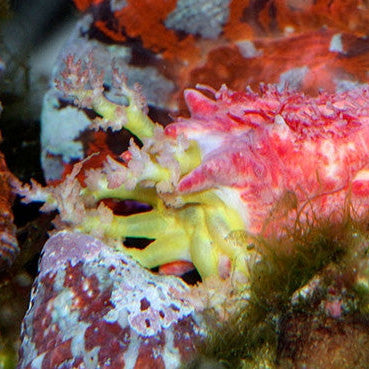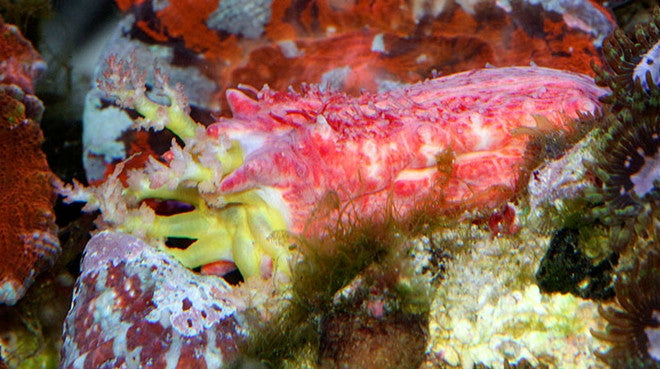Year End Clearance Sale 50% Off All Corals
Free Shipping Over $249 or $29.99 for Orders over $100
Spiny Sea Cucumber
$ 31.99
Please select all options.
How to Care for Spiny Sea Cucumber
written by Dave Burr
A colorful and bizarre addition to any reef aquarium, the Spiny Sea Cucumber can live for many years in the home aquarium. The Spiny Sea Cucumber uses its oral tentacles to catch food that floats by. As each tentacle becomes full of food it draws its entire tentacle into its mouth. The Spiny Sea Cucumber should be target feed fed foods for filter feeders including marine snow, phytoplankton, and zooplankton.
Behavior: It will move around the aquarium until it finds an area with a good current where it can filter plenty of food. Once it finds a desirable spot it may stay there for many months.
Feeding:
The Spiny Sea Cucumber should be target fed foods for filter feeders including marine snow, phytoplankton, and zooplankton. If not properly fed, the body of the Spiny Sea Cucumber will slowly begin to shrink. Try creating a storm in your aquarium using a turkey baster to blow jets of water into the dead spots of the aquarium to stir up the detritus. Then sit back and watch as it feeds on bits of detritus that float by.
CAUTION! When harassed, and upon death, the Spiny Sea Cucumber may release toxins that could kill fish in the aquarium. Do not house with butterflyfish, large angelfish, or other fish that are not safe with invertebrates. If you observe a fish picking at it, remove the fish or the Spiny Sea Cucumber immediately to a separate tank.
Tip: The Spiny Sea Cucumber can be harmed by the intakes of any pumps or powerheads in the aquarium, so make sure to protect all intakes to prevent the Spiny Sea Cucumber from being sucked in.
Vivid Aquariums cannot accept any responsibility for any losses that may occur should the Spiny Sea Cucumber poison the aquarium. Instances of Spiny Sea Cucumber's causing death in reef aquariums are very rare but it can happen. It’s a gamble- you choose to roll the dice, or not.
Care Level: Moderate
Reef Compatible: Yes
Diet: Filter Feeder
Range: Indo Pacific
Family: Holothuriidae
Water Conditions: 75-80° F; sg 1.024-1.026 (1.025 is ideal); pH 8.1-8.4 Ca 420-440 ppm, Alk 8-9.5 dKH, Mg 1260-1350, Nitrates <10ppm, Phosphates < .10ppm
Water Chemistry: It is important that proper calcium (420-440 ppm), alkalinity (8-9.5 dkh - run it 7-8 if you are carbon dosing) , and magnesium levels (1260-1350 ppm) are maintained. Raising magnesium levels gradually up to 1400-1600 ppm can help to combat algae outbreaks, just keep CA and Alk in line as you raise the Mg. Nitrates should be below 10 ppm and phosphates should be below .10 ppm. We recommend doing a water change when Nitrate levels rise to 10 ppm. It is important to replace your phosphate media when phosphates rise to .10 ppm. Media Reactors make the most efficient use of your phosphate media by fluidizing it.
Dosing: Vivid Aquariums uses and recommends dosing pumps to automate the dosing of additives and keep your levels more constant. A dosing pump can alleviate the chore of manually dosing your aquarium with Ca, Alk, & Mg 2,3, or 4 times per week and will benefit your aquarium by keeping your levels constant through frequent small additions of Ca, Alk, & Mg. Our tanks all progressed when we switched from 3 manual dosings per week to 70 automatic dosings per week and we got a lot more work done.
Video
Category: 25-50, Cucumbers, moderate, pentacta-anceps
Type: Invert



